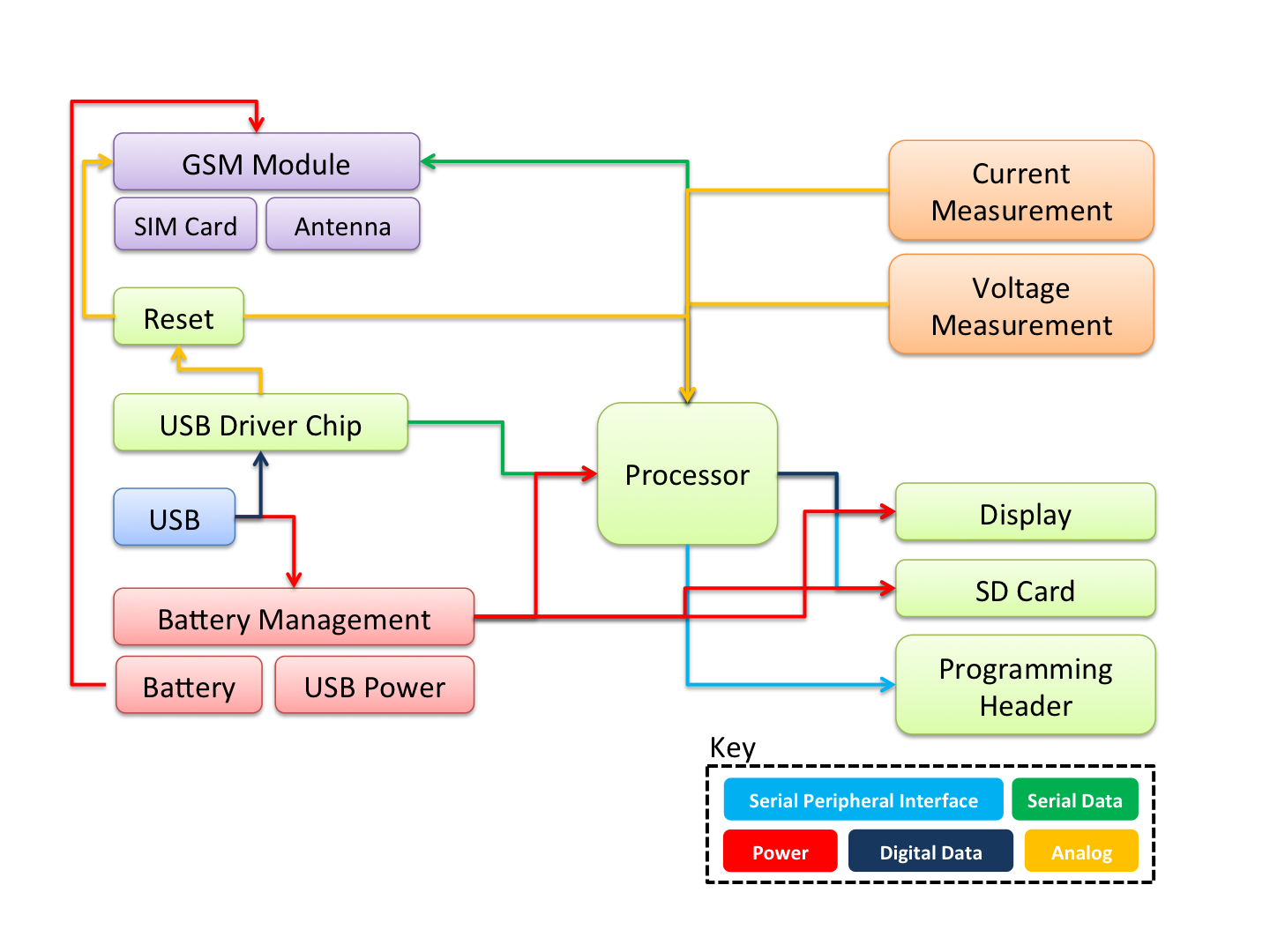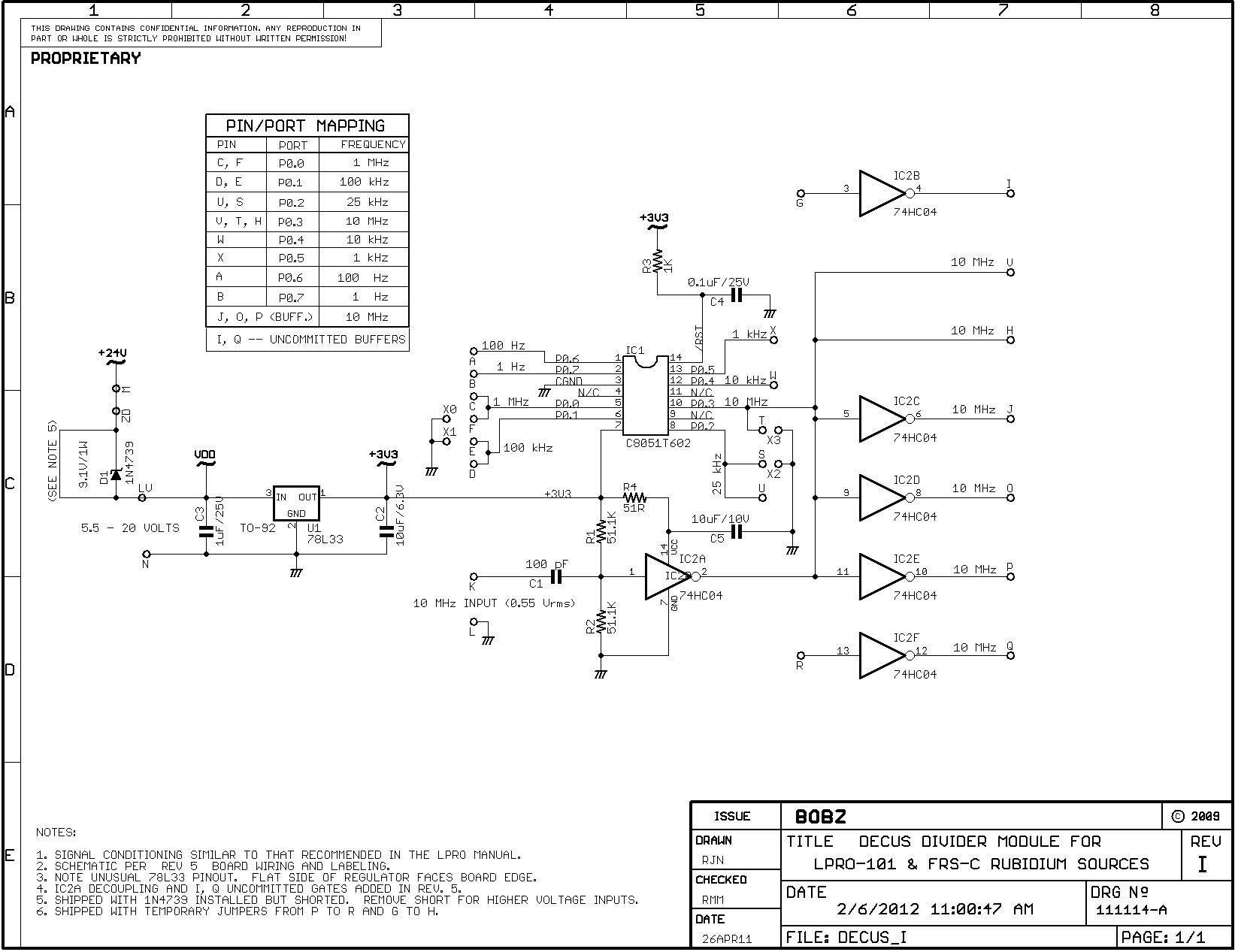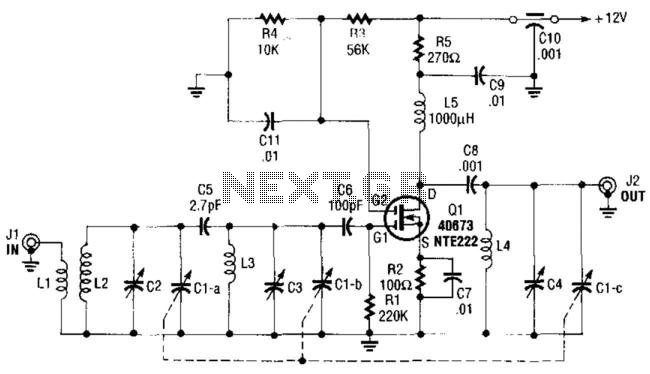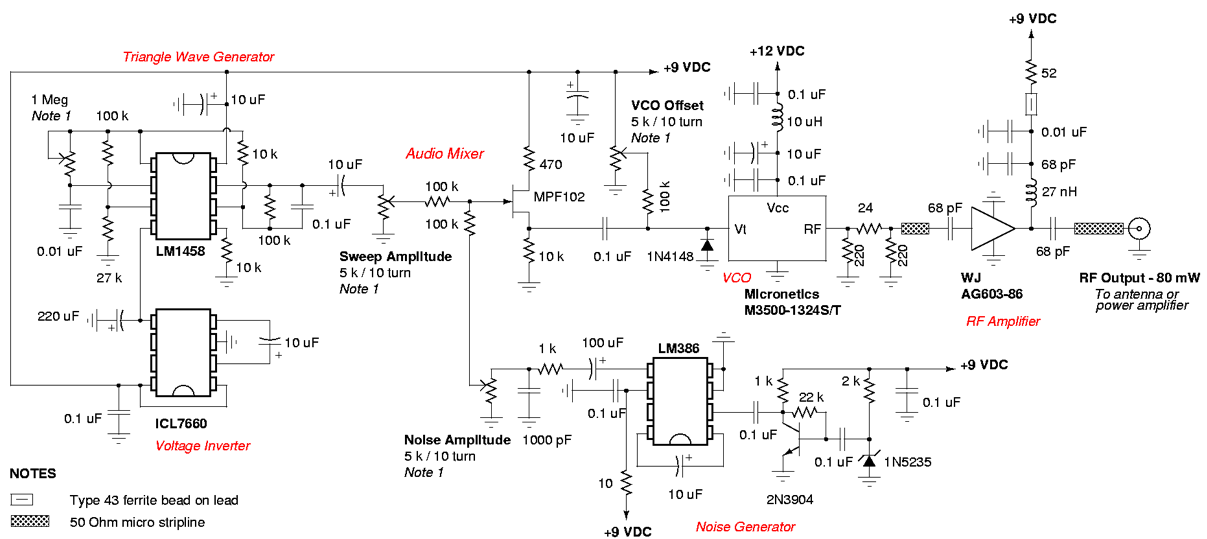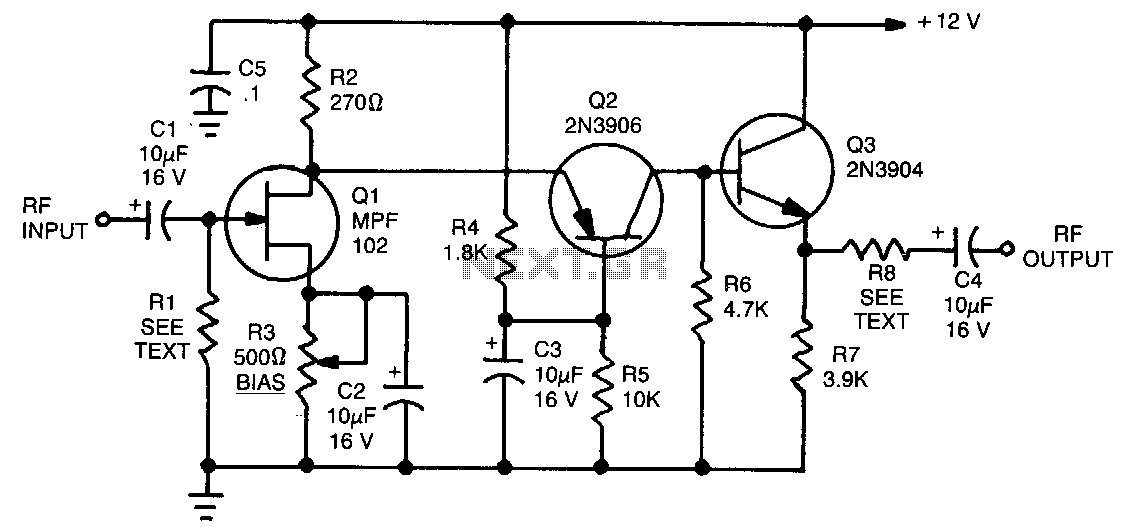
RF-AMP Documentation
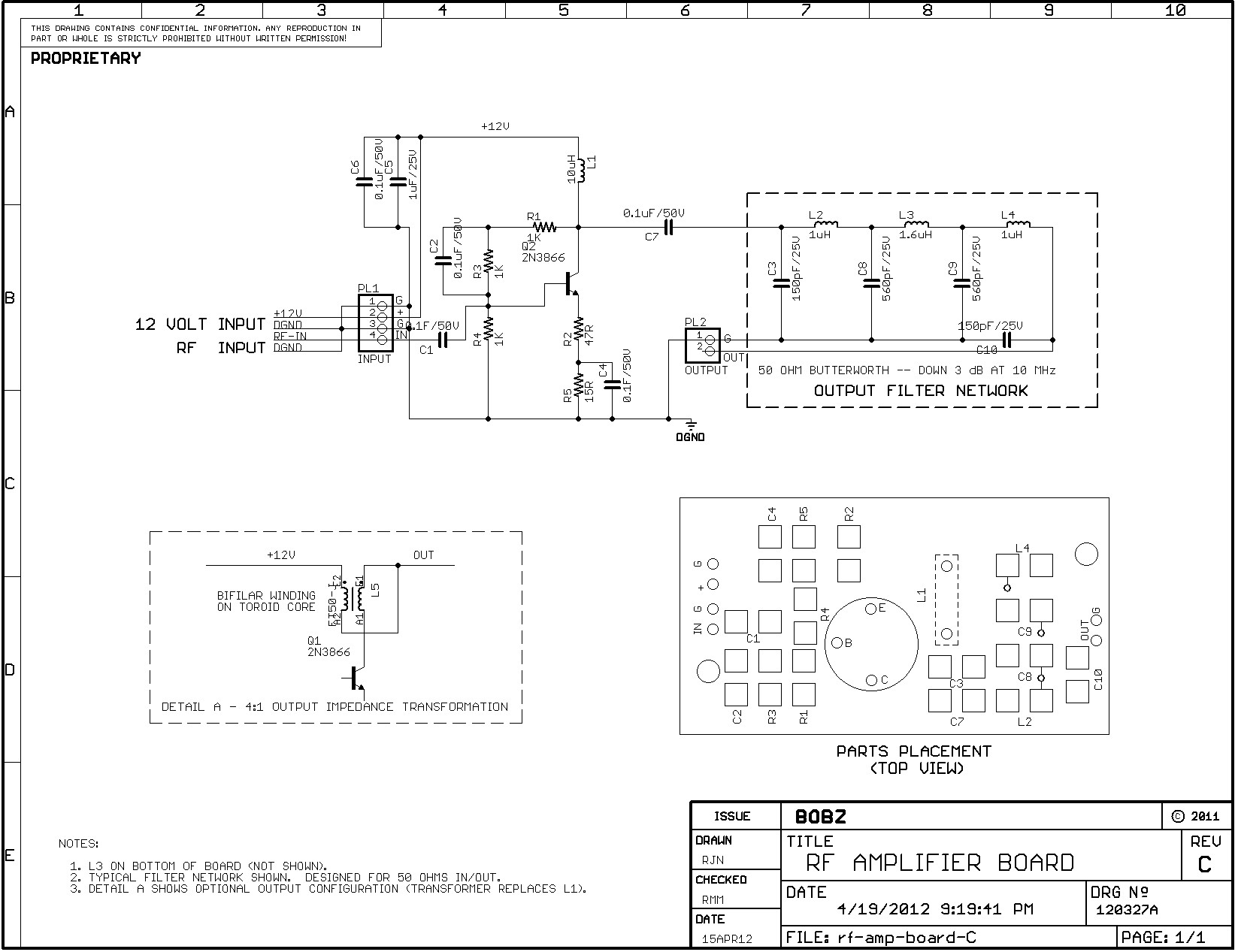
The amplifier is suitable for various projects to buffer and amplify outputs from devices such as Direct Digital Synthesizer (DDS) chips. It was initially designed to amplify the output of the 9833 DDS chip and is also intended for Amateur Radio applications, such as a buffer amplifier for a Variable Frequency Oscillator (VFO). The board is available in two configurations: one bare and the other fully populated with components, excluding the optional output filter network. The design includes a bifilar wound 4:1 output transformer, as outlined in the schematic. The RF-Amplifier circuitry and a typical configuration of the optional output network are depicted in the schematic. It is important to note that frequencies above 10 MHz are significantly attenuated with the provided filter network. The schematic illustrates the board's component layout, circuitry, and connection points. The amplifier offers a voltage gain of approximately 16 to 18 dB. A gain versus frequency plot for the basic amplifier board is provided, optimized for the 3-10 MHz range with a 2000 Ohm load. This plot includes results for three different transformer windings. Additionally, a gain versus load plot for the basic amplifier board is presented for the three windings mentioned earlier, indicating that the output impedance of the amplifier is approximately 220 Ohms without the 4:1 winding and about 150 Ohms with the impedance transformer. The reduction observed over the 12 turn transformer does not achieve the expected 4:1 ratio due to differences in collector impedances for the two transformers. The collector loading for both transformers is comparable but not identical. With the 4:1 transformer, at a 2000 Ohm load and a frequency of 6 MHz, the voltage ratio between the collector and secondary of the transformer was measured as (4220 mV rms)/(2210 mV rms)=1.91, which is close to the expected ratio of 2:1, as impedance transforms as the square of the voltage. A gain versus frequency plot of an amplifier board optimized for lower frequency operation (e.g., 300-400 kHz) with the optional 4:1 output transformer is also included. A load plot for the same low-frequency amplifier indicates that the output impedance, determined by the point where the load reduces gain by one-half, is approximately 100 Ohms. It is noted that the available supply voltage for the low-frequency plots was only 11.8 Volts; thus, the gain would be slightly higher with a full 12 Volt supply. The amplifiers utilize an FT50-J core, which is suitable for operation from a few hundred kilohertz to several megahertz. For higher frequency applications, the type 43 core provides better performance.
The amplifier circuit is designed to enhance signal integrity and performance in various applications, particularly in radio frequency (RF) systems. The use of the 9833 DDS chip as a signal source allows for precise frequency generation, making the amplifier essential for applications where signal fidelity is crucial. The incorporation of a bifilar wound 4:1 output transformer serves to match impedance and optimize power transfer between stages, significantly improving overall system efficiency.
The voltage gain specifications indicate that the amplifier is capable of providing a substantial increase in signal strength, which is critical in RF applications where weak signals must be amplified for further processing. The gain versus frequency plots illustrate the amplifier's performance across different frequency ranges, highlighting its suitability for both high-frequency and low-frequency applications. The distinction in output impedance under different configurations is important for ensuring compatibility with various load conditions, which can affect signal quality and amplifier stability.
The choice of core material in the transformer is vital for determining the amplifier's operational bandwidth. The FT50-J core is optimal for medium frequencies, while the type 43 core is recommended for higher frequency operations due to its superior magnetic properties. This attention to core selection ensures that the amplifier maintains performance across the intended frequency ranges, thus catering to a wide array of RF applications.
In summary, this amplifier circuit is a versatile solution for buffering and amplifying signals in DDS-based projects and Amateur Radio applications, demonstrating flexibility in design and robust performance across various frequency ranges.The amplifier can be used in a number of projects to buffer and amplify outputs from devices such as Direct Digital Synthesizer (DDS) chips. The board was initially produced to amplify the output of the 9833 DDS chip. The board was also intended for Amateur Radio applications (e. g. , a buffer amplifier for a VFO). Photo 1 shows the bare board and a board populated with all components except the optional output filter network. The board shown uses a bifilar wound 4:1 output transformer (as shown on the schematic and mentioned below). Schematic 1 shows the RF-Amp circuitry and a typical configuration of the optional output network. Note: with the given filter network, frequencies above 10 MHz are greatly attenuated. The schematic shows the board`s component layout, circuitry and connection points. The amplifier provides a voltage gain of approximately 16 to 18 dB. Photo 2 shows a gain vs. frequency plot of the basic amplifier board with an output optimized for the 3-10 MHz range (2000 Ohm load).
Shown on this plot are the results for three different transformer windings, as follows: Photo 3 shows a gain vs. load plot of the basic amplifier board for the three windings given above. These plots show that the output impedance of the amplifier is approximately 220 Ohms without the 4:1 winding.
With the impedance transformer, the output impedance is reduced to approximately 150 Ohms. The reduction over the 12 turn transformer is not 4:1 probably because the differences between the collector impedances for the two different transformers; the collector loading for the two transformers is comparable, but not exact. With the 4:1 transformer, a 2000 Ohm load and a frequency of 6 MHz, the voltage ratio between the collector and secondary of the transformer was (4220 mV rms)/(2210 mV rms)=1.
91. This is very close to the expected ratio of 2:1 (impedance transforms as the square of the voltage). Photo 4 shows a gain vs. frequency plot of an amplifier board optimized for operation at a lower frequency (e. g. , 300-400 kHz) connected with the optional 4:1 output transformer shown in the schematic. Photo 5 shows a load plot for the same low frequency amplifier. The output impedance, as determined by the point that the load reduces gain by one-half, is approximately 100 Ohms. Because the available supply voltage was only 11. 8 Volts for the low frequency plots, the gain will be somewhat larger with a full 12 Volt supply. Also note that the amplifiers use a FT50-J core, as noted. This core is good for operation at a few hundred kilohertz to several megahertz. For higher frequency operation, the type 43 core gives better results. 🔗 External reference
The amplifier circuit is designed to enhance signal integrity and performance in various applications, particularly in radio frequency (RF) systems. The use of the 9833 DDS chip as a signal source allows for precise frequency generation, making the amplifier essential for applications where signal fidelity is crucial. The incorporation of a bifilar wound 4:1 output transformer serves to match impedance and optimize power transfer between stages, significantly improving overall system efficiency.
The voltage gain specifications indicate that the amplifier is capable of providing a substantial increase in signal strength, which is critical in RF applications where weak signals must be amplified for further processing. The gain versus frequency plots illustrate the amplifier's performance across different frequency ranges, highlighting its suitability for both high-frequency and low-frequency applications. The distinction in output impedance under different configurations is important for ensuring compatibility with various load conditions, which can affect signal quality and amplifier stability.
The choice of core material in the transformer is vital for determining the amplifier's operational bandwidth. The FT50-J core is optimal for medium frequencies, while the type 43 core is recommended for higher frequency operations due to its superior magnetic properties. This attention to core selection ensures that the amplifier maintains performance across the intended frequency ranges, thus catering to a wide array of RF applications.
In summary, this amplifier circuit is a versatile solution for buffering and amplifying signals in DDS-based projects and Amateur Radio applications, demonstrating flexibility in design and robust performance across various frequency ranges.The amplifier can be used in a number of projects to buffer and amplify outputs from devices such as Direct Digital Synthesizer (DDS) chips. The board was initially produced to amplify the output of the 9833 DDS chip. The board was also intended for Amateur Radio applications (e. g. , a buffer amplifier for a VFO). Photo 1 shows the bare board and a board populated with all components except the optional output filter network. The board shown uses a bifilar wound 4:1 output transformer (as shown on the schematic and mentioned below). Schematic 1 shows the RF-Amp circuitry and a typical configuration of the optional output network. Note: with the given filter network, frequencies above 10 MHz are greatly attenuated. The schematic shows the board`s component layout, circuitry and connection points. The amplifier provides a voltage gain of approximately 16 to 18 dB. Photo 2 shows a gain vs. frequency plot of the basic amplifier board with an output optimized for the 3-10 MHz range (2000 Ohm load).
Shown on this plot are the results for three different transformer windings, as follows: Photo 3 shows a gain vs. load plot of the basic amplifier board for the three windings given above. These plots show that the output impedance of the amplifier is approximately 220 Ohms without the 4:1 winding.
With the impedance transformer, the output impedance is reduced to approximately 150 Ohms. The reduction over the 12 turn transformer is not 4:1 probably because the differences between the collector impedances for the two different transformers; the collector loading for the two transformers is comparable, but not exact. With the 4:1 transformer, a 2000 Ohm load and a frequency of 6 MHz, the voltage ratio between the collector and secondary of the transformer was (4220 mV rms)/(2210 mV rms)=1.
91. This is very close to the expected ratio of 2:1 (impedance transforms as the square of the voltage). Photo 4 shows a gain vs. frequency plot of an amplifier board optimized for operation at a lower frequency (e. g. , 300-400 kHz) connected with the optional 4:1 output transformer shown in the schematic. Photo 5 shows a load plot for the same low frequency amplifier. The output impedance, as determined by the point that the load reduces gain by one-half, is approximately 100 Ohms. Because the available supply voltage was only 11. 8 Volts for the low frequency plots, the gain will be somewhat larger with a full 12 Volt supply. Also note that the amplifiers use a FT50-J core, as noted. This core is good for operation at a few hundred kilohertz to several megahertz. For higher frequency operation, the type 43 core gives better results. 🔗 External reference
